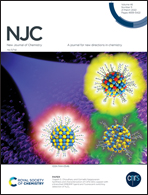Design and synthesis of benzothiadiazole-based molecular systems: self-assembly, optical and electronic properties†
Abstract
A set of small benzothiadiazole (BTD)-based derivatives with a D–A–D architecture were synthesized and characterized as building blocks of organic semiconducting materials by applying an experimental–theoretical approach. The four derivatives tend to self-assemble into highly ordered crystalline solids, with varying degrees of responsiveness to mechanical and thermal stimuli. The featured derivatives exhibit absorption maxima in solution and molar extinction coefficient values related to π–π* electronic transitions with minor solvatochromic responses, displaying broad fluorescence profiles with large Stokes shifts and high fluorescence quantum yields. In the solid-state, the BTD derivatives display absorption maxima in the visible range and intense fluorescence emission of the n-butoxy and fluorene derivatives. The stability of the one-electron reduced and oxidized forms of all compounds was assessed by means of cyclic voltammetry, which complemented by DFT calculations allowed the identification of one BTD derivative (BuO-BTD) as a strong candidate for use as an electron transport layer in organoelectronic devices.



 Please wait while we load your content...
Please wait while we load your content...